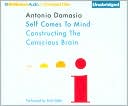Self Comes to Mind: Constructing the Conscious Brain
Search in google:
Self Comes to Mind is a nuanced and original chronicle of the evolution of the human brain. It reveals how the brain's development of a self becomes a challenge to nature's indifference and opens the way for the appearance of culture, a radical break in the course of evolution.Damasio views brain development through the lens of biological evolution -- starting with the simplest organisms that exhibit elaborate life regulation devices but do not require brains. The arrival of neurons, in some ways no different from other body cells, but also possessed of the unique ability to transmit and receive messages, allows neurons to organize themselves in complex circuits and networks, networks that serve to represent events occurring in the body, influence the function of other cells, even their own function. In this framework, the distinction between body and brain is blurred -- the neurons that make up the brain and eventually generate the mind are body cells and are perpetually connected to the body. Neurons are the producers of mind states. And in the increasing complexity of the patterns in which neurons organize themselves is to be found at once the mystery and the clues to the myriad ways in which the brain operates, manages life and controls human behavior in ways that we are only beginning to understand.The systems of neurons that govern life in the interior of a body - the process of homeostasis - are first assisted by reflex-like dispositions, and eventually by images, the basic ingredient of minds. But the flexibility and creativity of the human mind do not emerge from images alone. They require images to create a protagonist, a self capable of reflection. Once self comes to mind, the devices of reward and punishment, drives and motivations, and emotions, which have been present all along in at earlier evolutionary stages, can be controlled by an autobiographical self, capable of personal reflection and deliberation. The reflective self becomes a rebellious apprentice to nature's indifferent sorcerer. It uses expanded memory, language, and reasoning to create the very possibility of culture.This book is a pioneering synthesis of the author's original work over 30 years that attempts to explain how we became fully human--a work that, like Julian Jaynes' The Origin of Consciousness in the Breakdown of the Bicameral Mind, will be read for generations. The Barnes & Noble Review Antonio Damasio has a remarkable scientific imagination and an admirable literary style. The combination makes for fascinating reading. From the clinical data and the neuropsychological experimental work that has gathered both pace and precision in recent years, he draws compelling insights, forming a map of possibilities about the nature of that ultimate mystery, consciousness. He writes with such flair and confidence that it is almost as if he makes the mystery dissolve into knowledge before our eyes.
PART I STARTING OVER1 Awakening 3Goals and ReasonsApproaching the ProblemThe Self as WitnessOvercoming a Misleading IntuitionAn Integrated PerspectiveThe FrameworkA Preview of Main IdeasLife and the Conscious Mind2 From Life Regulation to Biological Value 31The Implausibility of RealityNatural WillStaying AliveThe Origins of HomeostasisCells, Multicellular Organisms, and Engineered MachinesBiological ValueBiological Value in Whole OrganismsThe Success of Our Early ForerunnersDeveloping IncentivesConnecting Homeostasis, Value, and ConsciousnessPART II WHAT'S IN A BRAIN THAT A MIND CAN BE?3 Making Maps and Making Images 63Maps and ImagesCutting Below the SurfaceMaps and MindsThe Neurology of MindThe Beginnings of MindCloser to the Making of Mind?4 The Body in Mind 89The Topic of the MindBody MappingFrom Body to BrainRepresenting Quantities and Constructing QualitiesPrimordial FeelingsMapping Body States and Simulating Body StatesThe Source of an IdeaThe Body-Minded Brain5 Emotions and Feelings 108Situating Emotion and FeelingDefining Emotion and FeelingTriggering and Executing EmotionsThe Strange Case of William JamesFeelings of EmotionHow Do We Feel an Emotion?The Timing of Emotions and FeelingsThe Varieties of EmotionUp and Down the Emotional RangeAn Aside on Admiration and Compassion6 An Architecture for Memory 130Somehow, SomewhereThe Nature of Memory RecordsDispositions Came First, Maps FollowedMemory at WorkA Brief Aside on Kinds of MemoryA Possible Solution to the ProblemMore on Convergence-Divergence ZonesThe Model at WorkThe How and Where of Perception and RecallPART III BEING CONSCIOUS7 Consciousness Observed 157Defining ConsciousnessBreaking Consciousness ApartRemoving the Self and Keeping a MindCompleting a Working DefinitionKinds of ConsciousnessHuman and Nonhuman ConsciousnessWhat Consciousness is NotThe Freudian Unconscious8 Building a Conscious Mind 180A Working HypothesisApproaching the Conscious BrainPreviewing the Conscious MindThe Ingredients of a Conscious MindThe ProtoselfConstructing the Core SelfThe Core Self StateTouring the Brain as It Constructs a Conscious Mind9 The Autobiographical Self 210Memory Made ConsciousConstructing the Autobiographical SelfThe Issue of CoordinationThe CoordinatorsA Possible Role for the Posteromedial CorticesThe PMCs at WorkOther Considerations on the Posteromedial CorticesA Closing Note on the Pathologies of Consciousness10 Putting It Together 241By Way of SummaryThe Neurology of ConsciousnessThe Anatomical Bottleneck Behind the Conscious MindFrom the Ensemble Work of Large Anatomical Divisions to the Work of NeuronsWhen We Feel Our PerceptionsQualia IQualia IIQualia and SelfUnfinished BusinessPART IV LONG AFTER CONSCIOUSNESS11 Living with Consciousness 267Why Consciousness PrevailedSelf and the Issue of ControlAn Aside on the UnconsciousA Note on the Genomic UnconsciousThe Feeling of Conscious WillEducating the Cognitive UnconsciousBrain and JusticeNature and CultureSelf Comes to MindThe Consequences of a Reflective SelfAppendix 299Notes 319Acknowledgments 343Index 345








